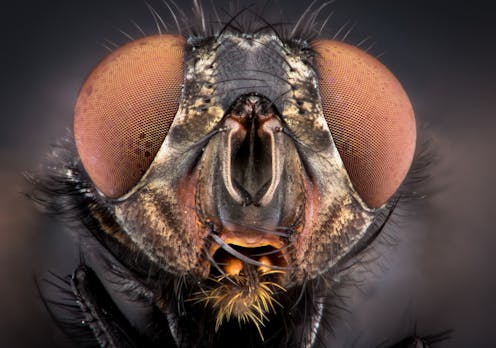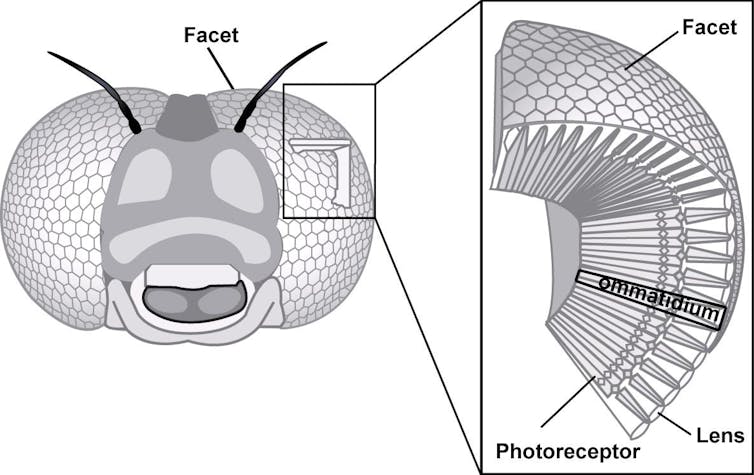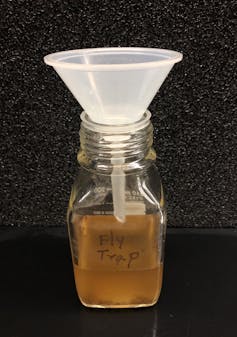Flies evade your swatting thanks to sophisticated vision and neural shortcuts
Why is it so difficult to swat a fly? A team of insect experts explains how a fly’s sophisticated vision allows it to quickly react to visual cues.

Sitting outside on a summer evening always sounds relaxing until flies and mosquitoes arrive – then the swatting begins. Despite their minuscule eyes and a brain roughly 1 million times smaller than yours, flies can evade almost every swat.
Flies can thank their fast, sophisticated eyesight and some neural quirks for their ability to escape swats with such speed and agility.
Our lab investigates insect flight and vision, with the goal of finding out how such tiny creatures can process visual information to perform challenging behaviors, such as escaping your swatter so quickly.
Faster vision
Flies have compound eyes. Rather than collecting light through a single lens that makes the whole image – the strategy of human eyes – flies form images built from multiple facets, lots of individual lenses that focus incoming light onto clusters of photoreceptors, the light-sensing cells in their eyes. Essentially, each facet produces an individual pixel of the fly’s vision.
A fly’s world is fairly low resolution, because small heads can house only a limited number of facets – usually hundreds to thousands – and there is no easy way to sharpen their blurry vision up to the millions of pixels people effectively see. But despite this coarse resolution, flies see and process fast movements very quickly.

We can infer how animals perceive fast movement from how quickly their photoreceptors can process light. Humans discern a maximum of about 60 discrete flashes of light per second. Any faster usually appears as steady light. The ability to see discrete flashes depends on the lighting conditions and which part of the retina you use.
Some LED lights, for example, emit discrete flashes of light quickly enough that they appear as steady light to humans – unless you turn your head. In your peripheral vision you may notice a flicker. That’s because your peripheral vision processes light more quickly, but at a lower resolution, like fly vision.
Remarkably, some flies can see as many as 250 flashes per second, around four times more flashes per second than people can perceive.
If you took one of these flies to the cineplex, the smooth movie you watched made up of 24 frames per second would, to the fly, appear as a series of static images, like a slide show. But this fast vision allows it to react quickly to prey, obstacles, competitors and your attempts at swatting.
Our research shows that flies in dim light lose some ability to see fast movements. This might sound like a good opportunity to swat them, but humans also lose their ability to see quick, sharp features in the dark. So you may be just as handicapped your target.
When they do fly in the dark, flies and mosquitoes fly erratically, with twisty flight paths to escape swats. They can also rely on nonvisual cues, such as information from small hairs on their body that sense changes in the air currents when you move to strike.
Neural tricks
But why do flies see more slowly in the dark? You may have noticed your own vision becoming sluggish and blurry in the dark, and much less colorful. The process is similar for insects. Low light means fewer photons, and just like cameras and telescopes, eyes depend on photons to make images.
But unlike a nice camera, which allows you to switch to a larger lens and gather more photons in dark settings, animals can’t swap out the optics of their eyes. Instead, they rely on summation, a neural strategy that adds together the inputs of neighboring pixels, or increases the time they sample photons, to form an image.
Big pixels and longer exposures capture more photons, but at the cost of sharp images. Summation is equivalent to taking photographs with grainy film (higher ISO) or slow shutter speeds, which produce blurrier images, but avoid underexposing your subjects. Flies, especially small ones, can’t see quickly in the dark because, in a sense, they are waiting for enough photons to arrive until they are sure of what they are seeing.
Flight maneuverability
In addition to rapidly perceiving looming threats, flies need to be able to fly away in a split second. This requires preparation for takeoff and quick flight maneuvers. After visually detecting a looming threat, fruit flies, for example, adjust their posture in one-fifth of a second before takeoff. Predatory flies, such as killer flies, coordinate their legs, wings and halteres – dumbbell-shaped remnants of wings used for sensing in-air rotations – to quickly catch their prey midflight.
How best to swat a fly
To outmaneuver a fly, you must strike faster than it can detect your approaching hand. With practice, you may improve at this, but flies have honed their escapes over hundreds millions of years. So instead of swatting, using other ways to manage flies, such as installing fly traps and cleaning backyards, is a better bet.
You can lure certain flies into a narrow neck bottle filled with apple cider vinegar and beer. Placing a funnel in the bottle neck makes it easy for them to enter, but difficult to escape.

As for mosquitoes, some commercial repellents may work, but removing stagnant water around the house – in some plants, pots or any open containers – will help eliminate their egg-laying sites and reduce the number of mosquitoes around from the start. Avoid insecticides, as they also harm useful insects such as bees and butterflies.
Jamie Theobald receives funding from the National Science Foundation (IOS-1750833).
Ravindra Palavalli-Nettimi does not work for, consult, own shares in or receive funding from any company or organization that would benefit from this article, and has disclosed no relevant affiliations beyond their academic appointment.
Read These Next
Why are some Black conservatives drawn to Nick Fuentes?
Black Americans and white nationalists have joined forces in the past. And a number of cultural and…
Rest is essential during the holidays, but it may mean getting active, not crashing on the couch
Unwinding can be hard during the holidays for many reasons. Building in time to recharge through active…
Why it’s so hard to tell if a piece of text was written by AI – even for AI
There are several methods for detecting whether a piece of text was written by AI. They all have limitations…





